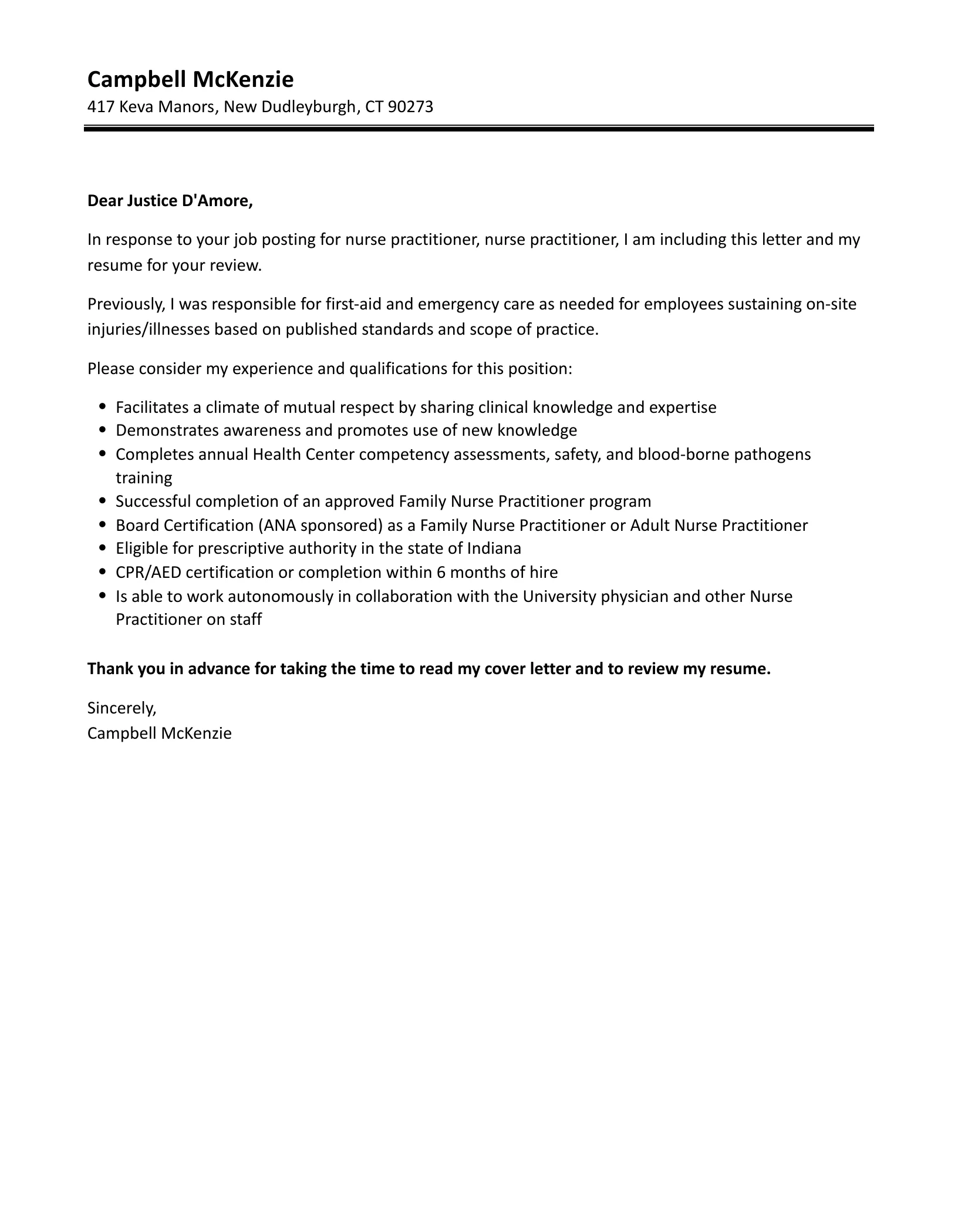Understanding the Importance of a Nurse Practitioner Cover Letter
A well-crafted cover letter is your first introduction to a potential employer, serving as a crucial companion to your resume. For Nurse Practitioners, a compelling cover letter goes beyond merely listing qualifications; it provides an opportunity to showcase your personality, passion for patient care, and the unique value you bring to a healthcare team. It allows you to elaborate on your experiences, explain your career aspirations, and demonstrate your understanding of the specific role you are applying for. Unlike a resume, which offers a snapshot of your career history, a cover letter allows you to tell a story, highlighting how your skills and experiences align with the needs of the employer and the specific requirements of the Nurse Practitioner position. A strong cover letter significantly increases your chances of landing an interview and ultimately securing your desired job.
Essential Elements of a Nurse Practitioner Cover Letter
To create a winning cover letter, several key elements are essential. Firstly, clear and concise contact information at the top is vital. This includes your full name, professional title, phone number, email address, and optionally, your LinkedIn profile URL. Secondly, a professional and respectful salutation addressing the hiring manager by name, if possible, demonstrates attention to detail and a genuine interest in the position. The body of your letter should then highlight your relevant skills and experience, quantify your achievements, tailor your letter to the specific job description, and express your passion for nursing and patient care. Finally, a strong conclusion summarizing your key qualifications and reiterating your interest in the position, along with a professional closing, completes the cover letter. Each element contributes to presenting you as a well-prepared and enthusiastic candidate.
Contact Information and Salutation
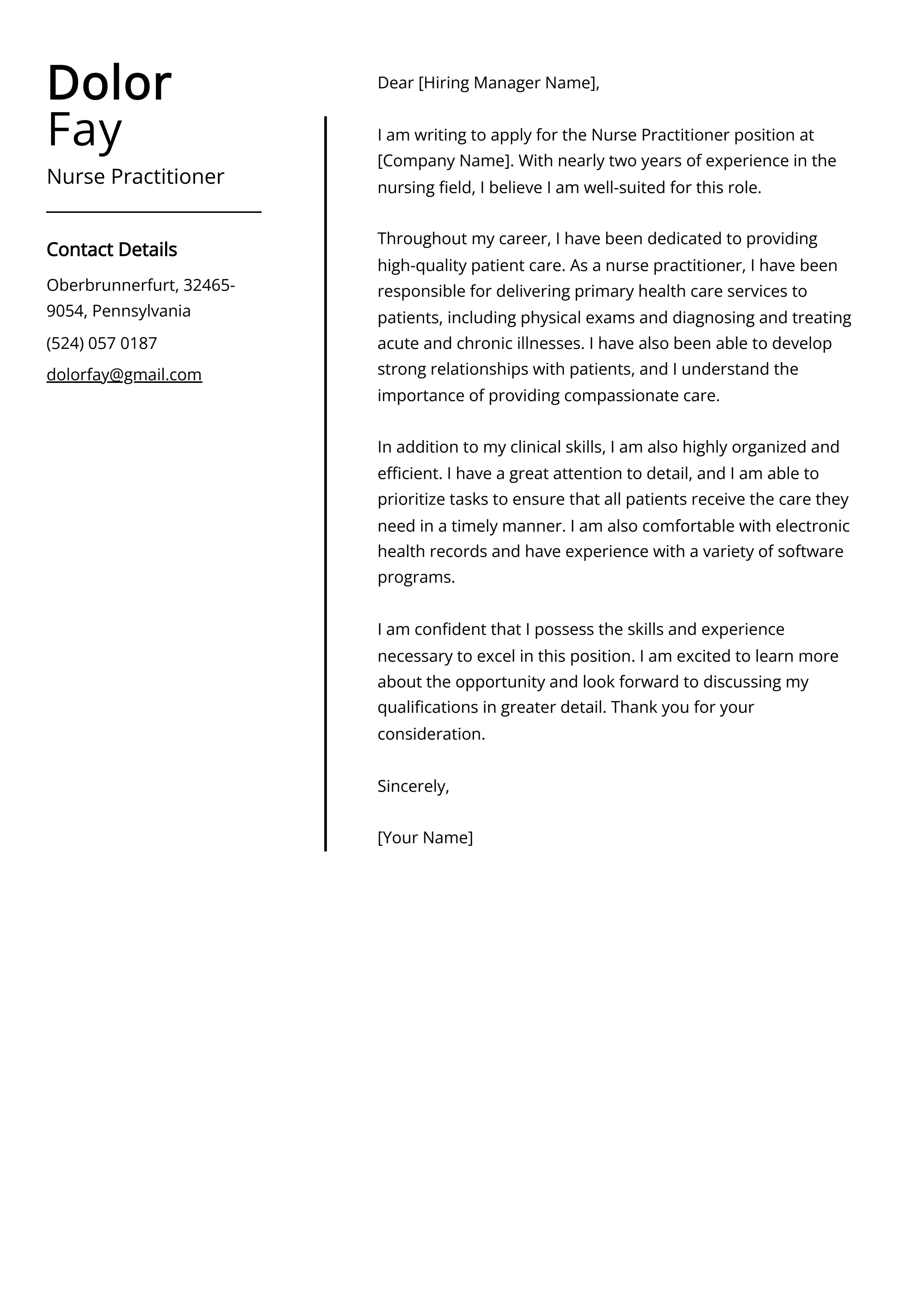
Begin your cover letter with your contact information, usually placed at the top left or right corner. Include your full name, professional title (e.g., Nurse Practitioner), phone number, email address, and LinkedIn profile URL if you have one. This ensures the hiring manager can easily reach you. Following your contact details, address the hiring manager with a professional salutation. If possible, find the name of the hiring manager through the job posting, the company website, or by calling the HR department. Use ‘Dear Mr./Ms./Dr. [Last Name]’ to show respect and personalize your application. If the hiring manager’s name is unavailable, use a general but professional greeting, such as ‘Dear Hiring Manager’ or ‘Dear [Department Name] Team’.
The Introduction Crafting a Strong Opening
The introduction is your first chance to make a positive impression. Start by clearly stating the position you’re applying for and where you found the job posting. Then, immediately capture the reader’s attention by mentioning something specific about the role or the healthcare organization that excites you. Briefly summarize your most relevant qualifications and experience to create a compelling hook. For example, you might highlight a specific skill, a notable accomplishment, or your passion for a particular area of nursing. The introduction should be concise, engaging, and set the tone for the rest of your letter, showcasing your enthusiasm and suitability for the Nurse Practitioner role. Keep the introduction brief, focused, and impactful to encourage the reader to delve deeper into your qualifications.
Highlighting Your Skills and Experience
The body of your cover letter is where you elaborate on your skills and experience. Focus on the skills and experiences most relevant to the Nurse Practitioner position. Carefully review the job description and identify the key requirements, then provide concrete examples of how you’ve demonstrated these skills in past roles. Use action verbs to describe your responsibilities and accomplishments. For instance, instead of saying ‘Responsible for patient care,’ use ‘Provided comprehensive patient care, including assessment, diagnosis, and treatment planning.’ Tailor the language to align with the job description, using keywords and phrases to demonstrate that you meet the employer’s needs. This section should showcase your clinical expertise, patient management abilities, and any specialized knowledge areas, making it clear why you are the ideal candidate for the role.
Quantifying Achievements and Impact
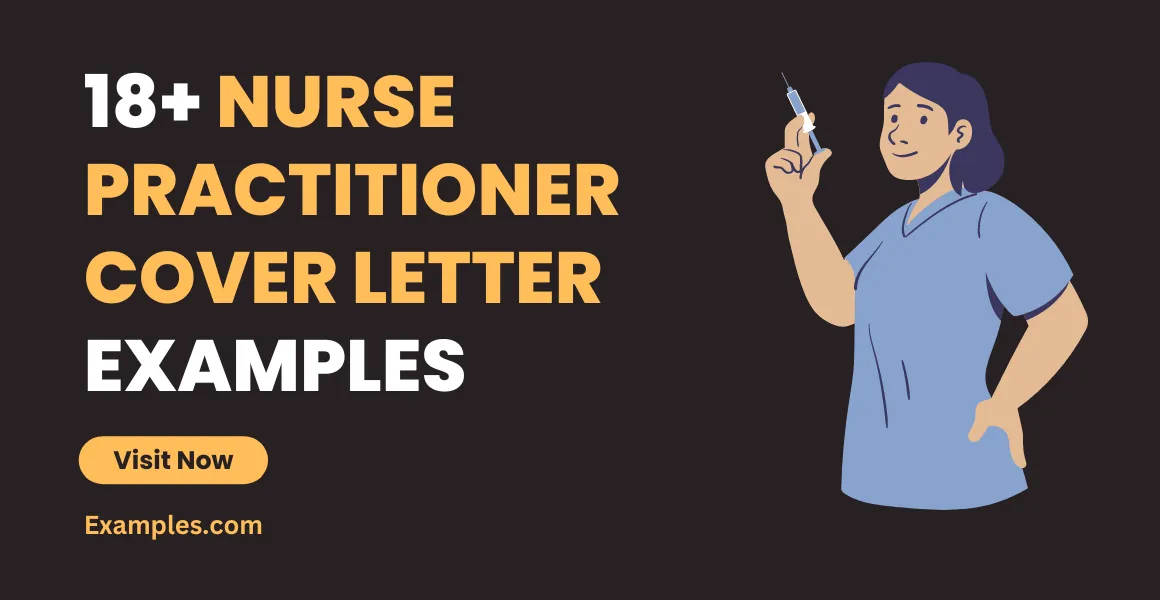
Go beyond simply listing your duties; quantify your achievements to demonstrate your impact. Whenever possible, use numbers, percentages, and specific data to illustrate your successes. For example, instead of saying ‘Improved patient satisfaction,’ write ‘Increased patient satisfaction scores by 15% through implementation of a new patient communication protocol.’ Quantifying your accomplishments makes your claims more credible and demonstrates the tangible results you’ve achieved. Consider using metrics such as the number of patients seen, reduction in readmission rates, improvements in patient outcomes, or successful implementation of new healthcare initiatives. This approach allows employers to easily assess your value and contributions, setting you apart from other applicants by providing concrete evidence of your capabilities as a Nurse Practitioner.
Tailoring Your Letter to the Job Description
A generic cover letter is unlikely to impress. Tailoring your cover letter to each specific job application is essential. Carefully read the job description and identify the key skills, experience, and qualifications the employer is seeking. Then, customize your letter to address these specific requirements. Highlight relevant experiences and skills, using the same keywords and phrases as the job description where appropriate. This shows the hiring manager that you have carefully considered the position and understand what the employer is looking for. If the job posting mentions specific software, procedures, or patient populations, be sure to include examples of your experience in these areas. Tailoring your cover letter demonstrates your attention to detail and your understanding of the role, significantly increasing your chances of securing an interview.
Demonstrating Your Passion for Nursing
A successful cover letter should convey your passion for nursing and patient care. Share why you chose nursing as a career and what motivates you to excel in the field. Describe your specific interests within nursing, such as your dedication to a particular specialty (e.g., cardiology, pediatrics, or geriatrics) or your enthusiasm for patient education and advocacy. Discuss any relevant volunteer work, professional development activities, or other experiences that demonstrate your commitment to the profession. Your passion will shine through when you genuinely enjoy your work and the difference you make in patients’ lives. This enthusiasm will make you a more memorable candidate, showing the employer that you are not just qualified but also genuinely excited about the opportunity.
Expressing Your Career Goals and Aspirations
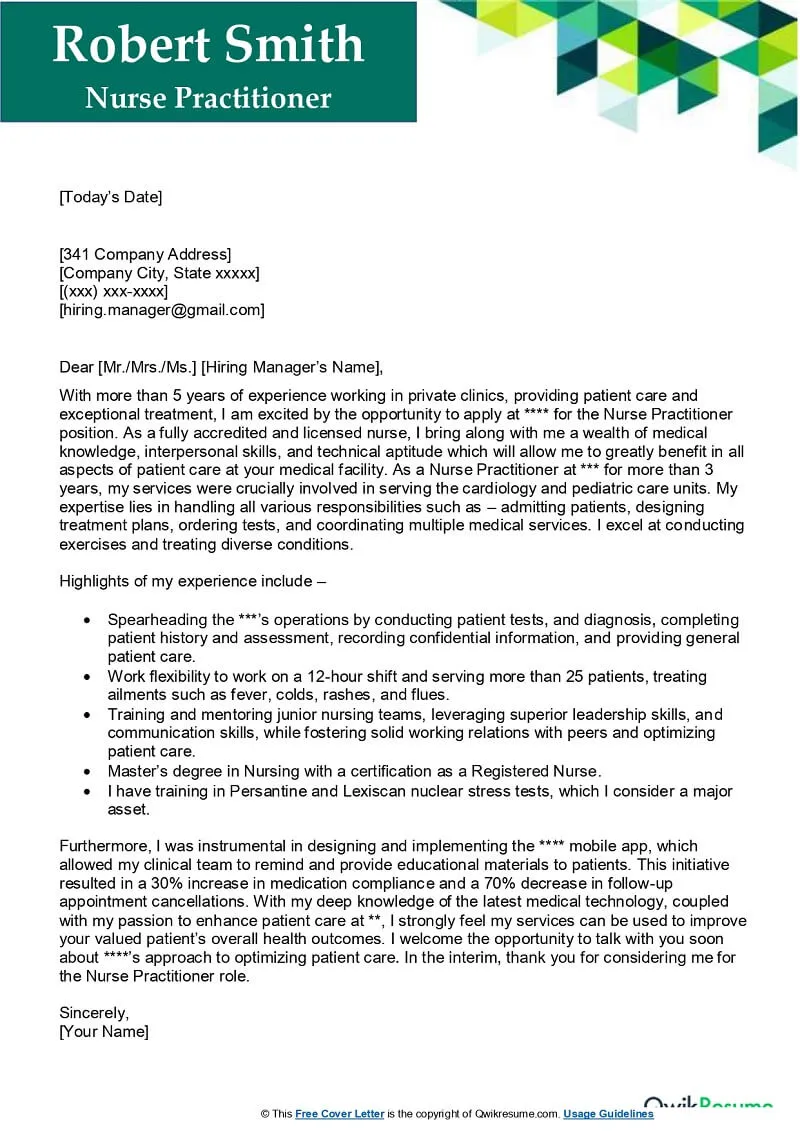
Briefly articulate your career goals and aspirations. This helps the employer understand your long-term vision and how the Nurse Practitioner position aligns with your professional objectives. Express your interest in the specific role and the healthcare organization. Explain how the position will help you develop your skills and advance your career. If you’re seeking opportunities for leadership, specialization, or professional development, mention it. By expressing your career goals, you demonstrate that you are not just looking for a job but a place where you can grow and contribute significantly. Be realistic and specific. Align your goals with the job description and the organization’s mission and values to show that you are a good fit for the team and the culture.
Concluding Your Cover Letter
Conclude your cover letter by summarizing your key qualifications and reiterating your interest in the position. Briefly restate why you are the ideal candidate and how your skills and experiences align with the job requirements. Express your enthusiasm for the opportunity to contribute to the healthcare organization. End with a call to action, such as ‘I am eager to discuss how my skills and experience can benefit your team. I am available for an interview at your earliest convenience.’ Use a professional closing, such as ‘Sincerely,’ ‘Best regards,’ or ‘Thank you for your time and consideration,’ followed by your typed name. Ensure that your contact information is readily available, and thank the hiring manager for considering your application. A strong conclusion leaves a lasting positive impression.
Formatting and Proofreading Your Cover Letter
Proper formatting and meticulous proofreading are critical for a professional cover letter. Use a standard font such as Times New Roman, Arial, or Calibri, and maintain a consistent font size (11 or 12 points). Use single spacing within paragraphs and double spacing between paragraphs to ensure readability. Keep the letter concise, ideally no more than one page. Use clear headings and bullet points to organize information and make it easy to scan. Ensure your letter has a professional look, with consistent margins and appropriate spacing. Prioritize readability. Poorly formatted letters suggest a lack of attention to detail, which is a critical quality in healthcare. By ensuring your letter is well-formatted, you present yourself as a polished and professional candidate, significantly improving your chances of success.
Proofreading for Errors
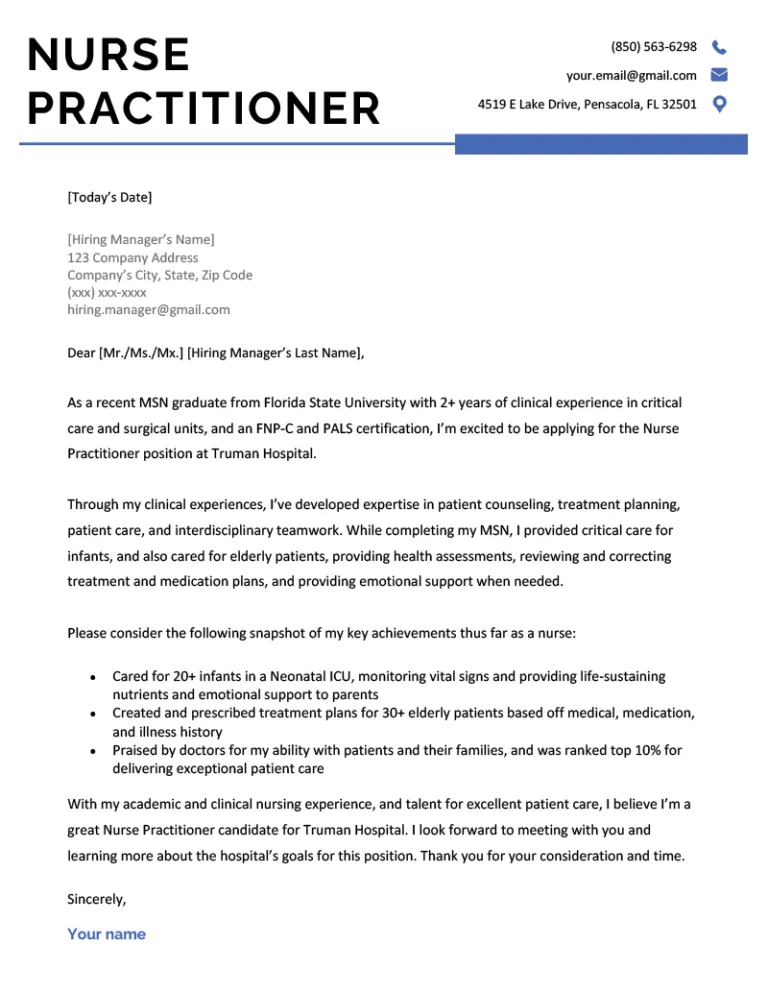
Thorough proofreading is essential to eliminate errors that can undermine your credibility. Before submitting your cover letter, carefully proofread for any grammatical errors, spelling mistakes, and punctuation issues. Read your letter aloud to catch errors you might miss when reading silently. Use spell-check and grammar-check tools, but don’t rely on them entirely; they can sometimes miss subtle errors. Ask a trusted friend, colleague, or mentor to review your letter for a second opinion. Ensure the language and tone are appropriate for a professional setting. A flawless cover letter demonstrates attention to detail and professionalism, reflecting well on your qualifications as a Nurse Practitioner.
Formatting Best Practices
Adhere to formatting best practices to ensure your cover letter is professional and easy to read. Use a clear and readable font such as Arial, Calibri, or Times New Roman, sized between 11 and 12 points. Set consistent margins (usually one inch on all sides). Use single spacing within paragraphs and double spacing between paragraphs. Use bolding for headings and subheadings to improve readability. Keep the letter to one page, making it concise and focused on the most relevant information. Properly format your contact information at the top and use a professional salutation and closing. Well-formatted cover letters not only look professional but also provide a better reading experience, increasing your chances of making a positive impression.
Submitting Your Nurse Practitioner Cover Letter
When submitting your cover letter, follow the specific instructions provided in the job posting. Most applications will require you to attach your cover letter and resume as PDF files to maintain formatting consistency. Always double-check that you are sending the correct documents and that the file names are clear and professional. If sending by email, use a professional subject line, such as ‘Nurse Practitioner Application - [Your Name]’. In the email body, briefly restate your interest in the position and thank the hiring manager for their consideration. Keep a copy of your submitted cover letter and resume for your records. By carefully following submission instructions, you demonstrate your attention to detail and professionalism, increasing your chances of success in your job application.
